Several times a year, events will pop up that include candy. Chocolate and other candy can be part of the renal diet, but there are some factors to consider. Some candy and chocolate are high in potassium and/or phosphorus, while others are low. In this article, we’ll cover the best and worst candy and chocolate options for a renal diet.
Table of Contents
Is candy okay for kidneys?
Long story short, yes, candy is okay for kidneys.
However, it’s not going to improve kidney health, similar to fast food. That being said, a few pieces of candy will not derail your kidney health goals.
Candy can provide more enjoyment in your life. The feeling of “I can’t eat anything here” can be so frustrating and upsetting when it comes to following a kidney-friendly diet.
Allowing some permission in these areas where it’s not going to make a huge difference can be very beneficial.
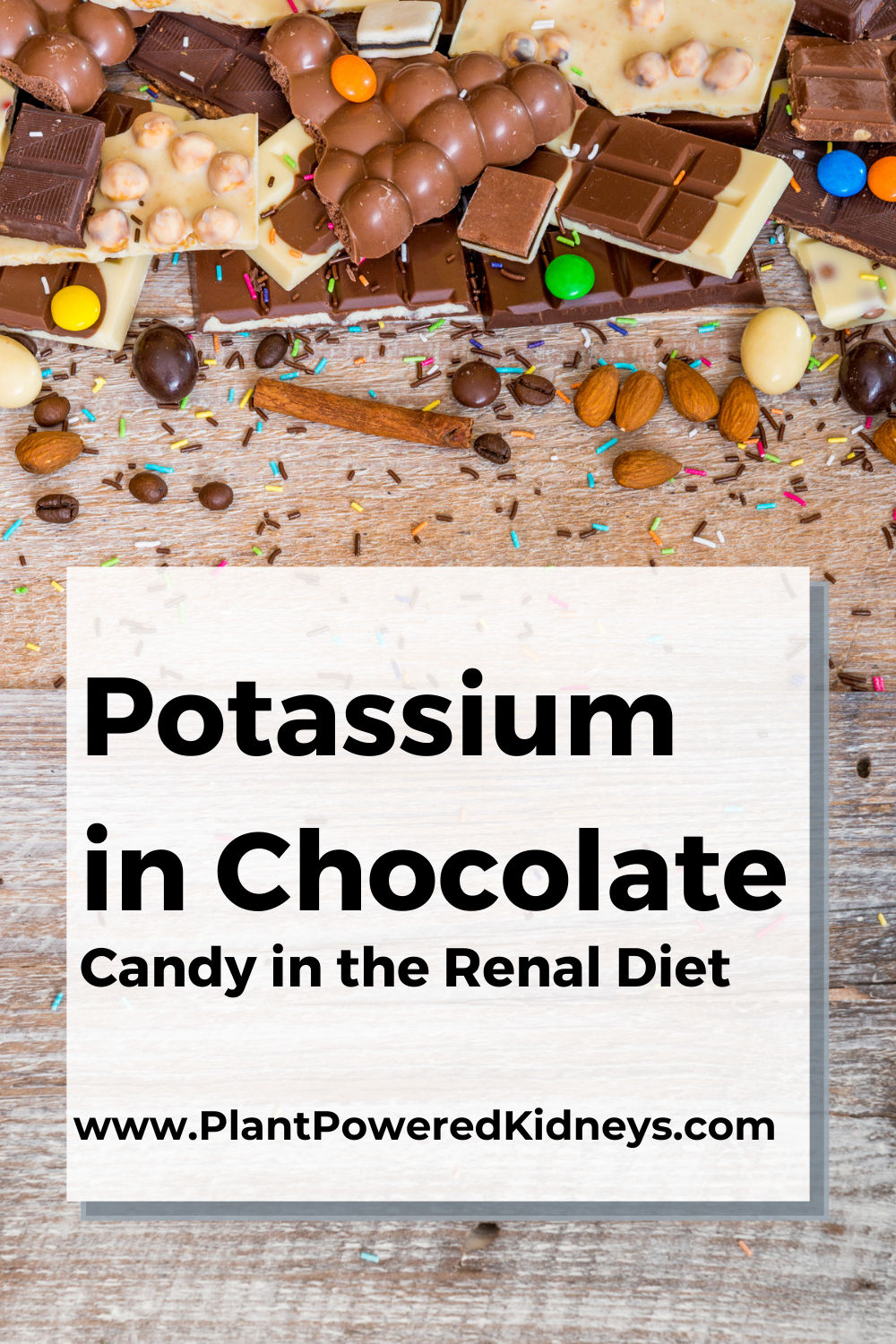
How much candy is okay?
The American Heart Association recommends women stick to an allowance of 6 teaspoons (25 grams, or 100 calories) of added sugar per day.
For men, the daily allowance is 9 teaspoons (36 grams, or 150 calories).
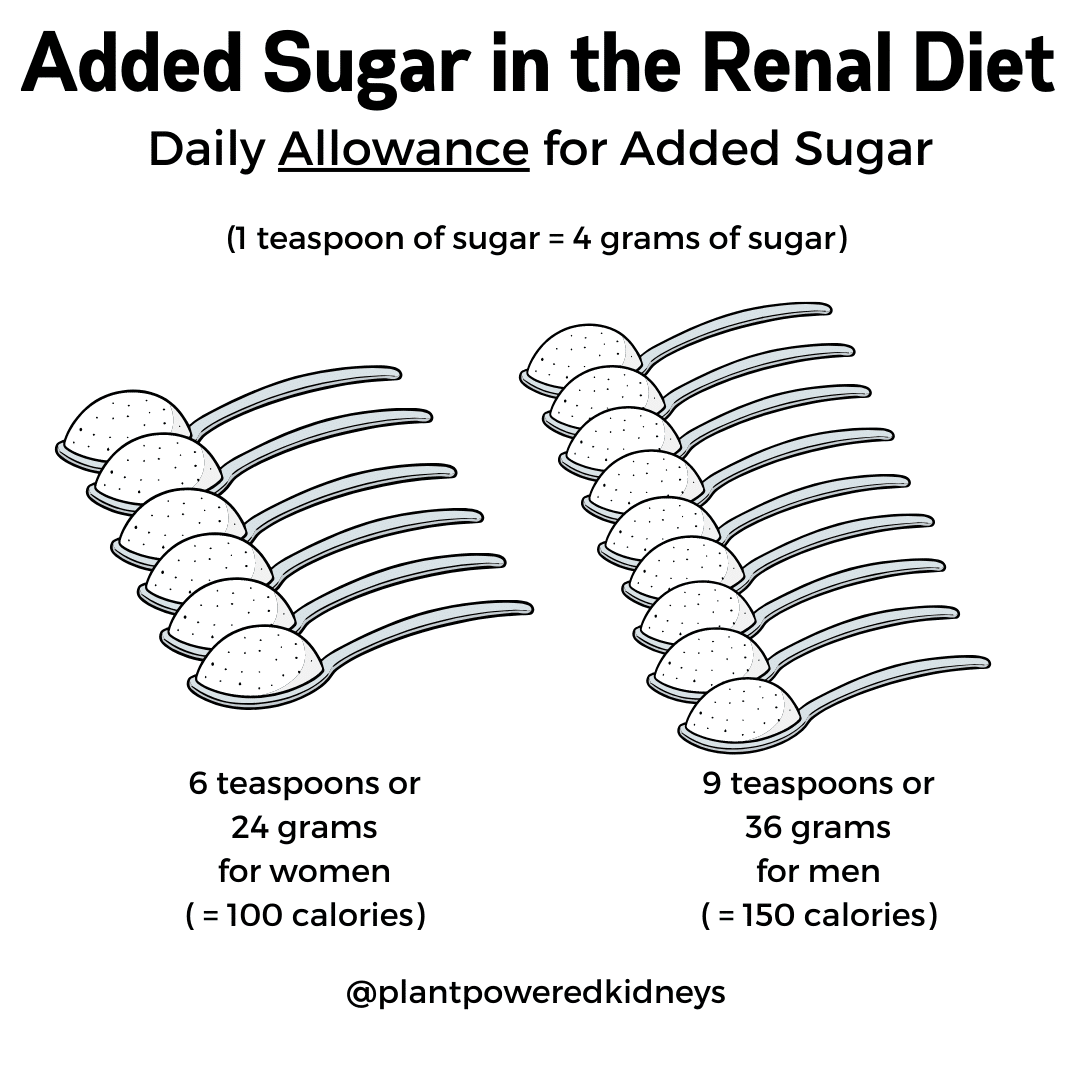
How to convert grams of sugar to teaspoons of sugar
The nutrition label will list the added sugar under the Total Carbohydrate section in grams.
We need to divide the number of grams of added sugar by 4 to determine how many teaspoons of sugar are in a food.
One teaspoon equals 4 grams of sugar.
For example, take a candy that has 8 grams of added sugar per serving. Divide that 8 grams of sugar by 4 grams per teaspoon and you get 2 teaspoons of sugar.
For women, that would be 2 of the 6 teaspoons of sugar allowance per day.
You can also think of it as simply 8 grams of added sugar of the allotted 25 grams per day – no math there!
What kidney-friendly candy can I have?
There are a ton of candy options that are acceptable when it comes to kidney health!
Here are some types of candies that we generally recommend:
- Fruity candies
- Hard candies
- Jelly beans
- Gumdrops
- Cinnamon/spicy candies
- Taffy
- Sour candies (another benefit with these is that they can help with a fluid restriction!)
- Toffee
- Caramels*
- Marshmallow candies
- Nougat
These candies are considered more kidney-friendly candy because they are lower potassium.
They also tend to have little to no phosphorus additives. However, it’s always important to check the label to be certain.
It’s still important to remember the added sugars, even if these are considered better candy options for the renal diet.
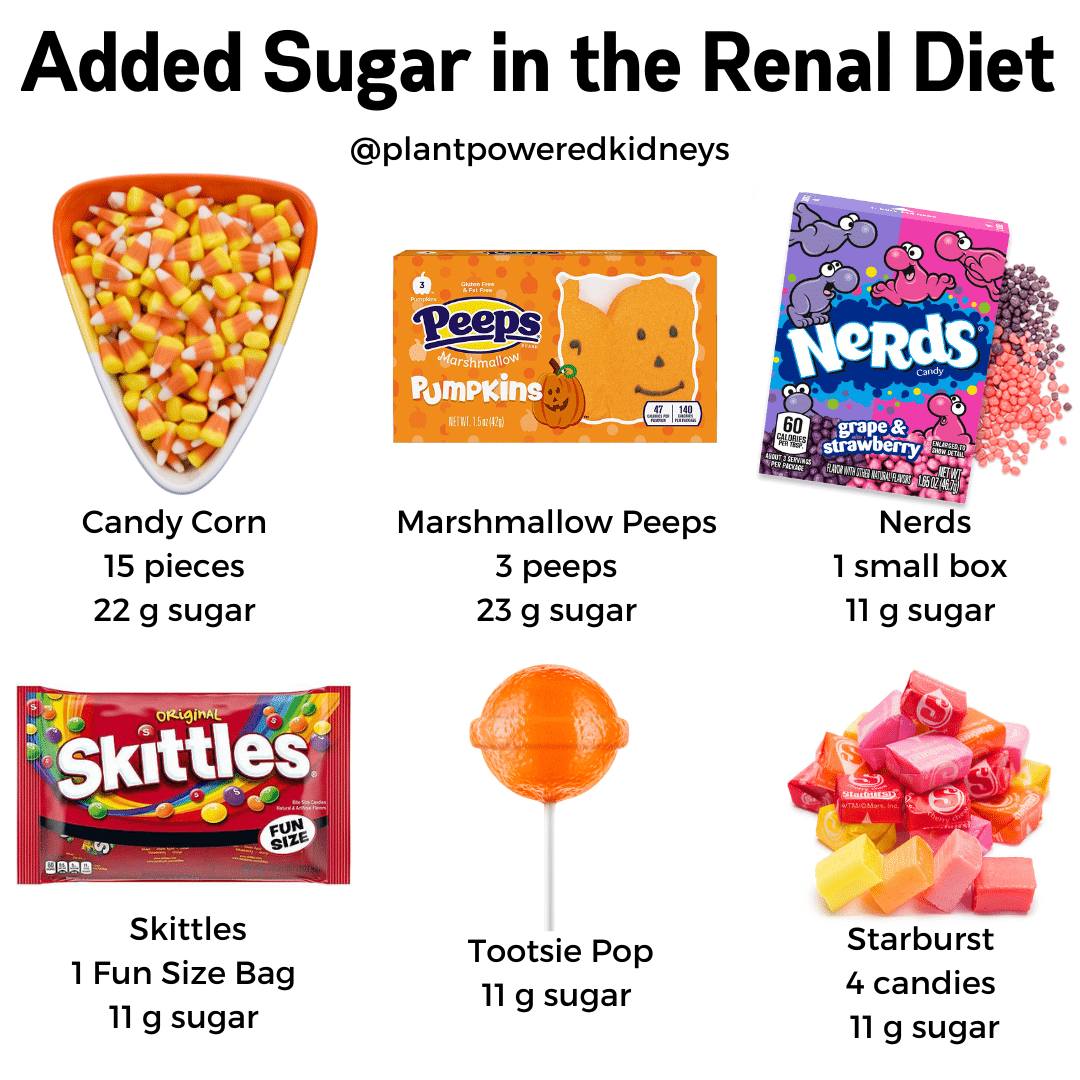
Read the nutrition label to check for any added phos or potassium ingredients because added preservatives are highly absorbed.

Candy to Limit on a Renal Diet
There are certain types of candies that are not seen as kidney friendly as other candies. The groups of candies not-so-kidney-friendly include candies with nuts, nut butter, and chocolate.
- Peanut brittle (In a 100-gram/3.5 ounce serving, it has 445 milligrams of sodium!)
- Chocolate-covered candies
- Candy bars
- Nuts
- Raisins
- Peanut butter candies
- Reese’s ®
These are higher in sodium, phosphorus, and potassium.
But keep in mind that there are still good nuts and nut butter that can fit into a renal diet – just without all the extra sugars that come from these types of candies.
Learn more about nuts in the renal diet here.
Candy to Avoid on a Renal Diet
One type of candy to avoid is black licorice.
Black licorice has been well-researched and connected to health complications for those with or without kidney disease.
A component in black licorice, glycyrrhizin, can cause severe and extreme drops in potassium.
This can lead to irregular heartbeat, high blood pressure, and congestive heart failure.
We don’t like to say no often. However, we’ll say no here to avoid potentially fatal health complications.

What about sugar-free kidney friendly candy?
Sugar-free doesn’t mean there should be a “free-for-all” of your favorite sweets.
Sugar-free candy can be lower in calories and sugar, but the replacement of the sugar can come from sugar alcohol.
Excessive sugar alcohols can lead to side effects including bloating, gas, and abdominal discomfort.
The other warning is that sugar-free candy can still increase the risk of type 2 diabetes.
This can be related to excessive calorie intake and weight gain from eating more candy that is thought to be harmless.
Choosing sugar-free candy over regular candy every now and then can help in lowering your calorie and sugar intake, so this is an option for people with or without diabetes.
As with all candies, though, sugar-free candy should still be consumed in moderation.
Is chocolate bad for kidneys?
We can’t talk about kidney-friendly candy and not discuss chocolate!
While chocolate itself isn’t “bad” for kidneys, there are certain nutritional components chocolate has that can be an issue for someone with kidney disease.
Types of Chocolate
There are three types of snacking or dessert chocolate you will find. They are:
- White chocolate
- Milk chocolate
- Dark chocolate
These three types are defined by the amount of chocolate liquor (cocoa butter and solids) and milk that is in the recipe.
Dark chocolate needs to contain at least 50% cocao solids. To qualify for the benefits of chocolate, the percentage of chocolate should be at least 70%.
Milk chocolate, on the other hand, contains only 10-50% cacao solids.
Most candies will generally not have this much cocoa unless specially labeled, like “75% cocoa.” If you don’t see this highlighted, it likely doesn’t qualify for any benefits of cacao.
Potassium in Chocolate
All types of chocolate contain some amounts of potassium. The different types will have different amounts of potassium.
Dark chocolate has the highest amount of potassium. One ounce of dark chocolate has approximately 158 milligrams of potassium.
Therefore, a bar of dark chocolate would be considered a high-potassium candy. A 3.5-oz dark chocolate bar (with 70-85% cacao) has approximately 722 milligrams of potassium.
White chocolate is considered a low-potassium chocolate. It has just 81 milligrams of potassium per ounce.
However, a 3.5-oz bar of white chocolate would contain about 284 milligrams of potassium, which would make it a high-potassium dessert.
Stick to a one-ounce portion if you are following a low-potassium diet. Or speak with your dietitian about how to fit chocolate into your diet safely.
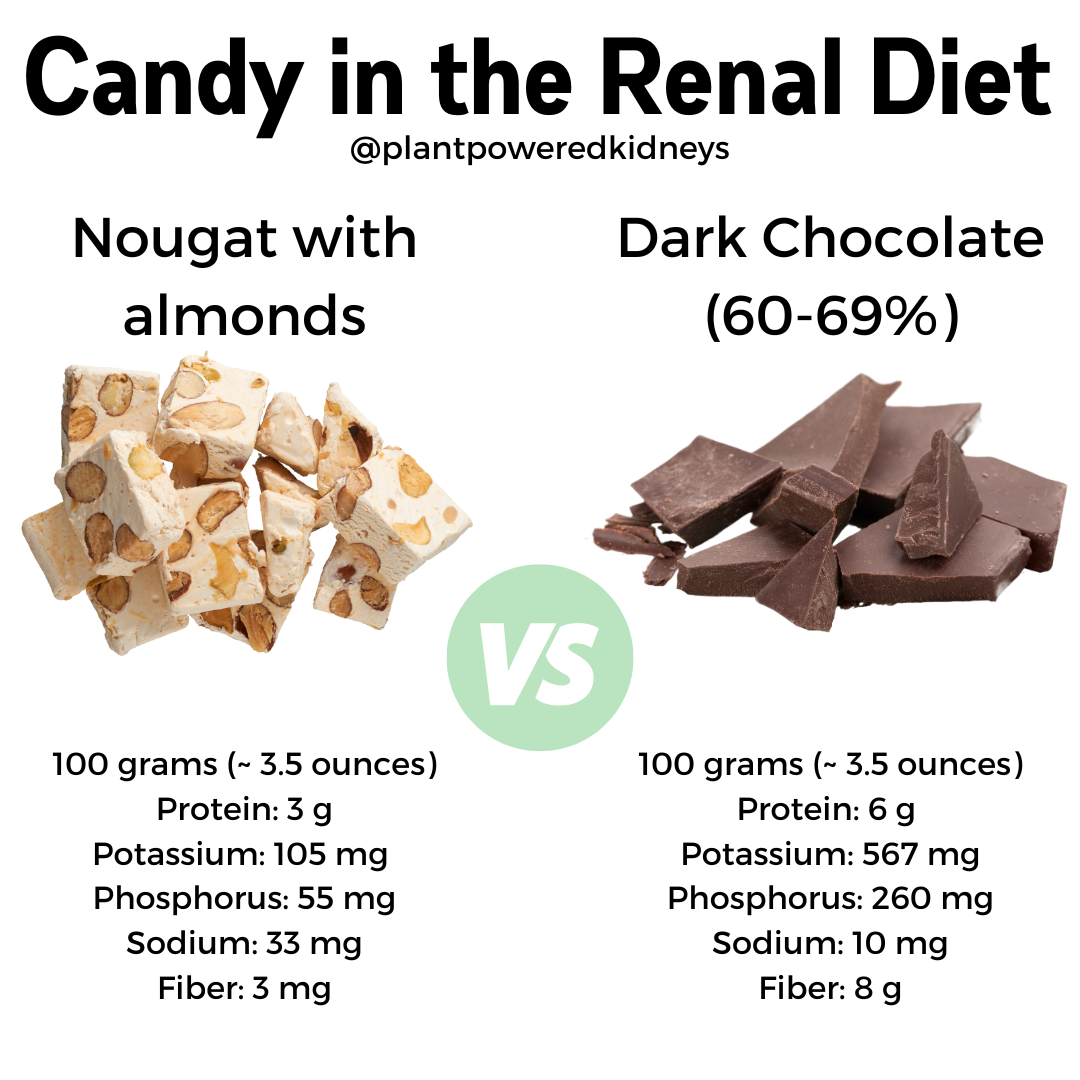
Chocolate and Phosphorus
Chocolate is also a source of organic phosphorus. Some types of chocolate candy can also have inorganic phosphorus.
Inorganic, or added phosphorus, is more highly absorbed into the blood.
A 1-oz serving of dark chocolate has 87 milligrams of phosphorus. A 3.5-oz chocolate bar of the same type of chocolate has 311 milligrams of phosphorus.
On the other hand, white chocolate is lower in phosphorus than dark chocolate.
A one-ounce portion of white chocolate contains just 50 milligrams of phosphorus. A 3.5-oz bar will contain approximately 175 milligrams of phosphorus.
Given that people with kidney issues often have trouble controlling their phosphorus levels, chocolate may be one of the first things to limit.
If you are prescribed phosphorus binders, taking binders with chocolate may help reduce the amount of phosphorus absorbed into the bloodstream.
Learn more about a low-phosphorus diet here.
Is Dark Chocolate Good for the Kidneys?
In 2015, a study was published that researched the benefits of cocoa on kidney health.
In using the flavanols of cocoa, they found that they protected the endothelium (lining) of kidneys and cardiovascular health.
The study also used a beverage with flavanol extract; they did not give the participants chocolate.
Keep in mind that flavanols are also found in fruits and vegetables. Many people with kidney disease aren’t getting enough fruits and vegetables.
Even though dark chocolate is higher in potassium and phosphorus, you may be able to include it in your renal diet.
If dark chocolate is something you would like to add to your diet, talk with your dietitian.
Oxalates and Chocolate
Another thing to consider is the oxalates in chocolate. For people that need to follow a low oxalate diet, chocolate may be a concern.
The cocoa itself is the source of oxalates. Therefore, chocolate with more cocoa will have a higher amount of oxalate.
White chocolate, for example, is a low oxalate source with just 1 milligram of oxalate per ounce.
Dark chocolate with over 70% cocoa has 39 milligrams of oxalate per ounce. This is a big amount for someone that needs to limit their daily oxalate intake.
Not everyone needs to limit oxalates. But if you do, this article about gout and kidney stones may be useful to you.
Chocolate Comparison Table
Below is a comparison table of the phosphorus and potassium contents of different types of chocolate. Each value is based on a 1-ounce serving.
| Chocolate Type | Potassium (mg) in 1 ounce | Phosphorus (mg) in 1 ounce | Oxalate (mg) in 1 ounce |
|---|---|---|---|
| White | 81 | 50 | 1 |
| Milk | 109 | 61 | 5 |
| Dark (70-85%) | 161 | 87 | 39 |
Data was collected from the USDA Food Database. Nutritional information may vary between products and brands.
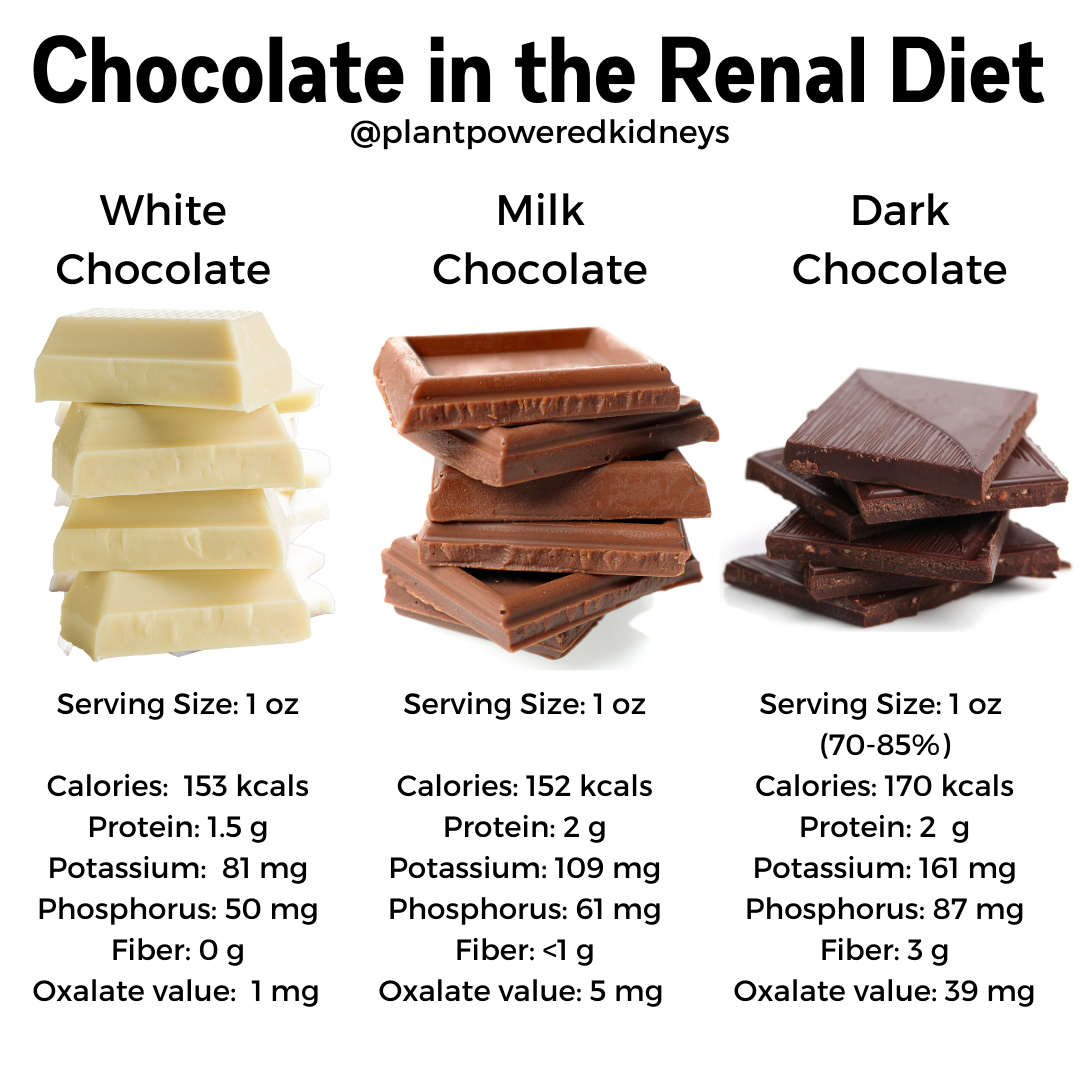
Ideas for leftover Candy
You may find yourself with leftover candy after certain holidays and events.
While you can keep them and enjoy small amounts from time to time, there are other ways to enjoy. Try these ideas on ways to get rid of the extra sweets laying around.
Donate
It feels good to share, so why not share with others that may not be as capable to spend money on extras like sweets?
Donate your extra candy to a local nursing home or food bank. They’ll be very appreciative of your generosity.
Be sure to check with your local food bank and nursing homes about any sanitation concerns prior to dropping off.
Make Yogurt Bark
Frozen yogurt bark is an easy treat that is fun for kids (and grown-ups) to make.
Find a yogurt that is lower in sugar since you’ll be sweetening it with your toppings (here are some of the best kidney-friendly yogurts).
To make your own yogurt bark, spread yogurt onto a baking sheet lined with parchment paper.
Chop or crush your candy and sprinkle on top of the yogurt. Freeze until solid.
Break into pieces and put into freezer containers. This can keep for several months in the freezer.
Homemade Trail Mix
Take some of your sweets and mix them with dry cereal, some nuts, or seeds. Now you’ve got yourself a festive snack that will satisfy any craving.
Try this Halloween-inspired trail mix recipe.


The trick is to add more nutrient-rich foods like whole grain cereals and plant-protein nuts and seeds. Doing this means we include slow-digesting carbohydrates and fiber.
This will help satisfy you more than just the small (or even large) handful of candy alone.
Save for a Dry Mouth
With kidney disease can come chronic dry mouth issues. This is no fun and even more challenging if you have a fluid restriction.
Keep some of your favorite hard candies in your purse or car. Use when your mouth is dry, but you need to limit fluids.
If you want to learn more about fluid restrictions, check out this article.
Treats for Troops
It’s hard to be away from family and friends when the holiday season comes up. Imagine missing several holidays and special occasions.
A wonderful thing to do is support our military by sending candy. to say that we are thinking of them.
Ask your dentist about Halloween Candy Buy Back
This is something that local companies, including dentists, have started up to help people from, well, getting too many cavities!
Learn more from Halloween Candy Buy Back. Check with your dentist to see if they participate or if they know of another dental office that does.
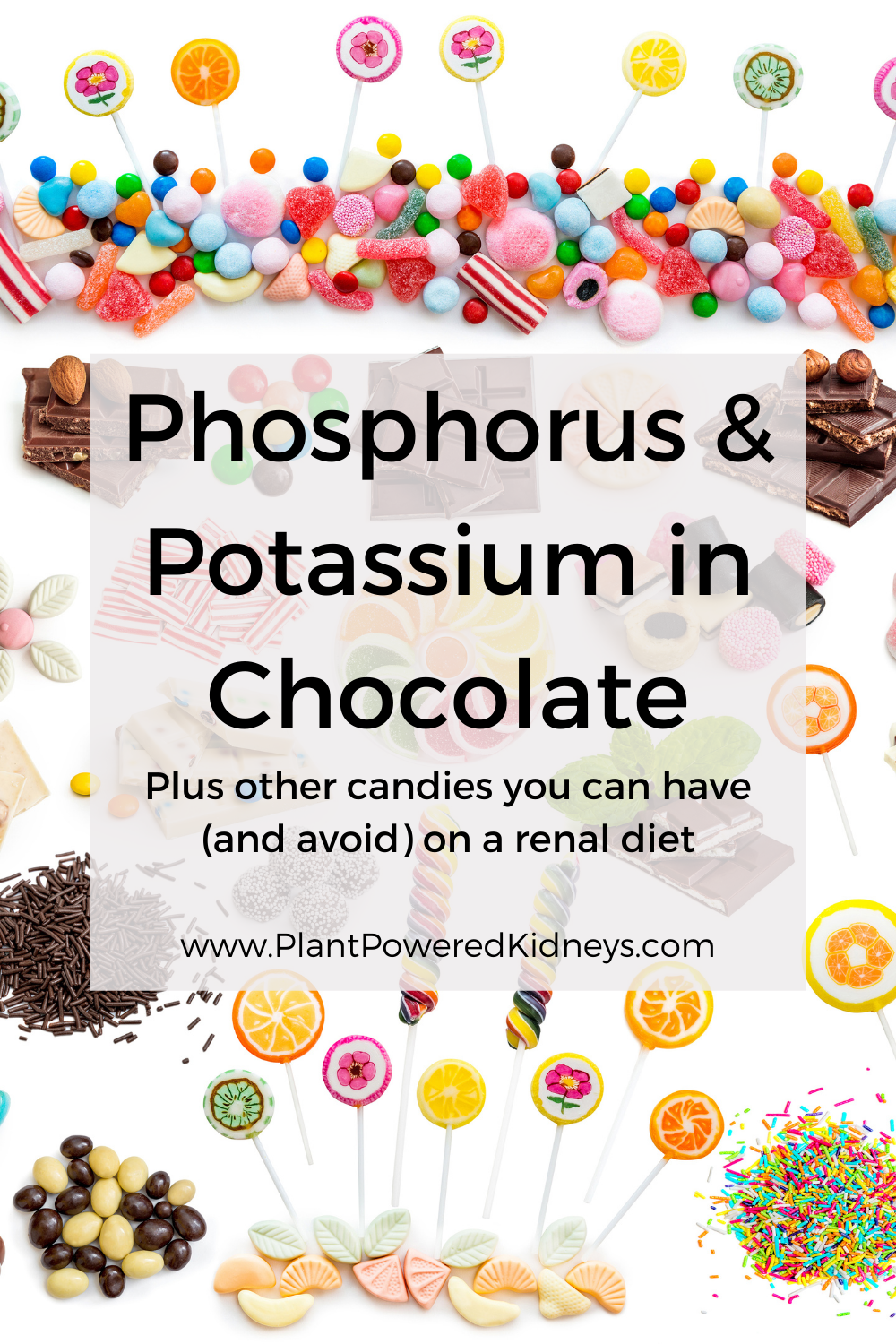
Summary
There are some kidney-friendly candy options and some that aren’t so kidney-friendly.
Fruity candies, sour candies, hard candies, jelly beans, and others in these groups can be better options for a renal diet.
Hard and sour candies are particularly good choices as they can also help with dry mouth and fluid restrictions. Sugar-free candies can be okay, but still in moderation.
Chocolate is higher in both phosphorus and potassium. While it may be able to fit, it should be limited if there are issues with controlling either phosphorus or potassium.
Other candies that won’t be as good an option include high-sodium peanut brittle, chocolate/nut candies, and peanut butter candies.
The top candy to avoid is black licorice. This can cause irregularities in potassium and blood pressure.
To help keep treats in check, add them to a snack that includes some fiber to slow down the absorption of sugars. Spread them out by making a kidney-friendly rendition of frozen yogurt bark.
If you just want to get them out of the house, donate them to soldiers or even your dentist office.
While candy won’t outright benefit your kidneys, there can be a place for it to fit. By giving ourselves permission to enjoy candy from time to time, it loses power over us and we remain in control of our health, kidneys, and all.

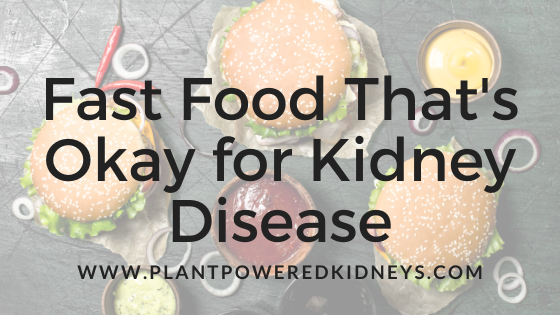

Thank you Jen!! Awesome information!
So happy to hear that, Linda!! 🙂
Is there a kidney safe cereal? I have no restrictions
Thank you
Stay tuned! 😉
is it ok to eat “twizzlers” on a ckd diet?
Twizzlers aren’t actual licorice, and mainly consist of sugar and some flour and cornstarch for binding. They do contain a potassium additive, however, so if potassium is an issue this may be something to limit (or switch to a potassium-additive-free candy).